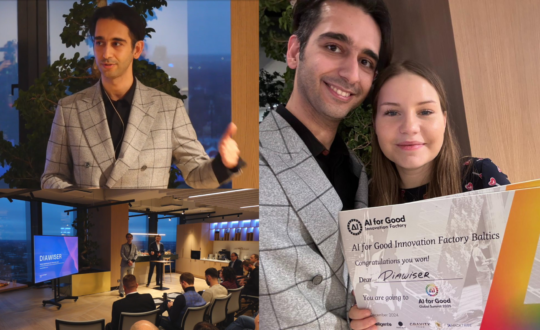Technology holds the potential to address some of today’s greatest life challenges. But it can’t facilitate effective education or boost the quality of everyday life without clear guiding principles.
To ensure benefits extend to everyone, new and emerging digital solutions must be guided by the core principles of inclusion and equity.
For example, artificial intelligence (AI)-enabled apps, when designed with and for communities, can help reduce barriers for differently-abled people to communicate and participate in everyday life.
Smartphone apps developed by Carlos Obando and Hugo Jácome, co-founders of Talov Studio, for example, can scan and read images for the visually impaired, or detect surrounding sounds and voices for hearing-impaired users, with situations transcribed continually in up to 48 languages.
The US-based Talov was a finalist at last year’s AI For Good Innovation Factory Grande Finale – a pitching competition to help start-ups scale up AI innovations in line with global sustainable development priorities.
Despite falling short of the 2021 Grand Prize, Talov won the popular vote as the audience favourite during a live poll.
Breaking down barriers
During the competition, Jácome introduced two smartphone applications, SpeakLiz and Vision, both aimed at tackling everyday barriers and fill gaps for people with accessibility needs.
SpeakLiz – using AI for real-time, multilingual transcription – is meant to revolutionize social interactions between hearing and deaf people. The app can identify over 140 different sounds, ranging from the human voice to music, alarms, cars, or animals.
It can also detect sign language movements, translating them to text or spoken words.
With the app still at the beta phase of development, it currently understands between 10 and 15 signs in four sign languages: American, German, Japanese, and French. But from this starting point, SpeakLiz will continue to expand its repertoire.
Along with helping users engage in conversation, the app could provide crucial help in life-threatening situations – even with a simple notification when an alarm is ringing.
Indexing the world
After creating SpeakLiz, the developers set out to help differently abled people surpass a broader range of societal barriers, developing apps for differing user needs and abilities.
With this in mind, Obando and Jácome developed their Vision app for blind and visually impaired people, whose information access may be additionally constrained by low availability of Braille text.
Vision detects imagery through a smartphone’s camera, giving users an audio notification of what is in front of them. The app measures distances, identify objects, and vocalizes text.
“Imagine trying to differentiate a one-dollar bill from a hundred-dollar bill without looking. It’s almost impossible,” explained Jácome. “Blind people are more vulnerable to thieves and people willing to take advantage of them.”
While major tech firms are developing similar applications, Talov has set itself apart with one key advantage – its independence form on online servers. The resultant lower latency was crucial to optimize the app, train the AI model and protect smartphone processors without draining the phone battery.
Next steps
Going forward, the company hopes to leverage AI-powered facial recognition to customize the app for each user. Vision would then be able to identify particular people, such as friends, family, and colleagues. The enhanced user experience could include reports such as: “Mum is in front of you.”
The Innovation Factory pitching competition helped Talov gain global brand awareness, the co-founders say. Recognition from the International Telecommunication Union (ITU) and 40 UN partners promoting AI for Good represents a significant asset.
Marketing has become a growing priority for the company.
“In theory, these kinds of products should go viral because they’re useful, but that is not necessarily the reality,” says Jácome. “We want to ensure the communities that could benefit from the technology get access to it.”
Learn more about this year’s Innovation Factory competition or watch the 2021 AI For Good Innovation Factory Grand Finale.












